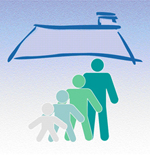Smoking 2008
Archived Content
Information identified as archived is provided for reference, research or recordkeeping purposes. It is not subject to the Government of Canada Web Standards and has not been altered or updated since it was archived. Please "contact us" to request a format other than those available.

Smoking is a risk factor for lung cancer, heart disease, stroke, chronic respiratory disease, and other conditions. Smoking is an important and preventable cause of death.
In 2008, 21.4% of Canadians aged 12 or older (24.3% of men and 18.5% of women) smoked either daily or occasionally. This was about the same rate as in 2007, but a significant decrease since 2003.
The trend was the same among smokers aged 16 to 17 and 18 to 19, with no significant change between 2007 and 2008, but a drop over the five-year period from 2003 to 2008.
Chart 1

Rates were highest among 20- to 34-year-olds, 28.8% of whom smoked daily or occasionally. One-third of men in this age group smoked, as did one-quarter of women.
Chart 2

The lowest smoking rates were among youths aged 12 to 15 (3.8%), and seniors (10.7%). Although the lowest smoking rates were at both ends of the age spectrum, the types of smokers were different. Among seniors who were smokers, 84.0% smoked daily, while 59.7% of smokers aged 12 to 19 did so. Non-smokers in these age groups differed as well: 60.2% of senior non-smokers were actually former smokers, compared with 11.6% of non-smokers aged 12 to 19.
People typically begin smoking during their teenage years, so the percentage of Canadians who have not started by age 20 is an indicator of future smoking rates. In 2008, 45.8% of Canadians aged 20 to 24 had never smoked. While this was about the same as in 2007, it was a significant increase over 2003.
Chart 3

About one-quarter of adults smoked in Newfoundland and Labrador, Quebec, Manitoba and Saskatchewan, significantly above the national average. Smoking rates were below the national average in Ontario (19.8%) and British Columbia (18.6%). In the other provinces, the rates were not significantly different from the national figure.
Smoking rates were much higher in the territories. More than half of Nunavut residents aged 12 or older were daily or occasional smokers, as were about one-third of those in Yukon and Northwest Territories.
In 2008 the difference between urban and rural smoking rates was small, but significant: 21.1% of the population over 12 years of age in urban areas versus 22.7% in rural areas were current smokers.
Source
Additional information from the Canadian Community Health Survey is available from CANSIM table 105-0501.
References
The journey to quitting smoking. Shields M. 2005; 16(3): 19-36.
Smoking bans: Influence on smoking prevalence. Shields M. 2007; 18(3): 9-24.
Youth smoking. Shields M. 2005; 16(3): 53-7.
- Date modified:
